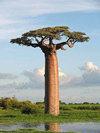石竹(Petopentia natalensis)尾状部分形成的特点布洛克(夹竹桃科)
IF 0.6
4区 生物学
Q4 PLANT SCIENCES
引用次数: 2
摘要
南非特有尾状植物Petopentia natalensis (Schltr.)种子和营养器官的解剖形态结构。牛蒡(夹竹桃科)在个体发生的不同阶段进行了研究:幼苗、幼苗和未成熟植株。人们注意到,纳塔勒木种子的胚乳发育与夹竹桃科中生植物代表种子的胚乳相似。幼苗的下胚轴也属于中植物型,而不是像Adenium obesum (Forssk)这样的多肉植物。Roem。& Schult。和Pachypodium lamerei Drake。在纳塔利木幼植株中,下胚轴带不断增加,形成茎的基部扩大。下胚轴和上胚轴的传导组织发育模式不同。茎的基部以分散在实质细胞之间的侧支维管束为代表,茎的爬升部分以完整的环为代表。与其他未成熟的尾形植物不同,P. natalensis具有束状的传导系统。一般来说,纳塔利木茎的基部膨大部分完全由下胚轴形成,主要是由于产生了大量的皮质细胞和髓实质细胞。本文章由计算机程序翻译,如有差异,请以英文原文为准。
Peculiarities of the formation of the caudiciform part of Petopentia natalensis (Schltr.) Bullock (Apocynaceae)
ABSTRACT The anatomical and morphological structure of the seeds and vegetative organs of the endemic caudiciform plant of South Africa Petopentia natalensis (Schltr.) Bullock (Apocynaceae) has been investigated at different stages of ontogenesis: seedlings, juvenile and immature plants. It has been noticed that endosperm of P. natalensis seeds is developed similar to endosperm of seeds of mesophytic representatives of the Apocynaceae family. Seedling hypocotyl is also of mesophytic type in contrast to those of such succulents as Adenium obesum (Forssk.) Roem. & Schult. and Pachypodium lamerei Drake. In juvenile plants of P. natalensis the hypocotylous zone is constantly increasing to form an enlarged basal part of the stem. Conducting tissues have a different pattern of development in the hypocotyl and epicotyl. In the basal part of the stem they are represented by collateral vascular bundles scattered among the parenchymal cells, while in the climbing part of the stem, the conducting system is represented by a complete ring. Unlike other immature caudiform plants, P. natalensis has the bundle type of conducting system. As a rule, the basal expanded part of the P. natalensis stem is formed exclusively from the hypocotyl and it occurs mostly due to generation of abundant number of cortical and pith parenchymal cells.
求助全文
通过发布文献求助,成功后即可免费获取论文全文。
去求助
来源期刊

Adansonia
生物-植物科学
CiteScore
1.30
自引率
12.50%
发文量
24
审稿时长
>12 weeks
期刊介绍:
Adansonia is a fast-track and peer-reviewed journal of plant biology, devoted to the inventory, analysis and interpretation of vascular plants biodiversity. It publishes original results, in French or English, of botanical research, particularly in systematics and related fields: morphology, anatomy, biology, ecology, phylogeny, biogeography, etc. All articles published in Adansonia are compliant with the different nomenclatural codes. A copyright assignment will be signed by the authors before publication.
 求助内容:
求助内容: 应助结果提醒方式:
应助结果提醒方式:


